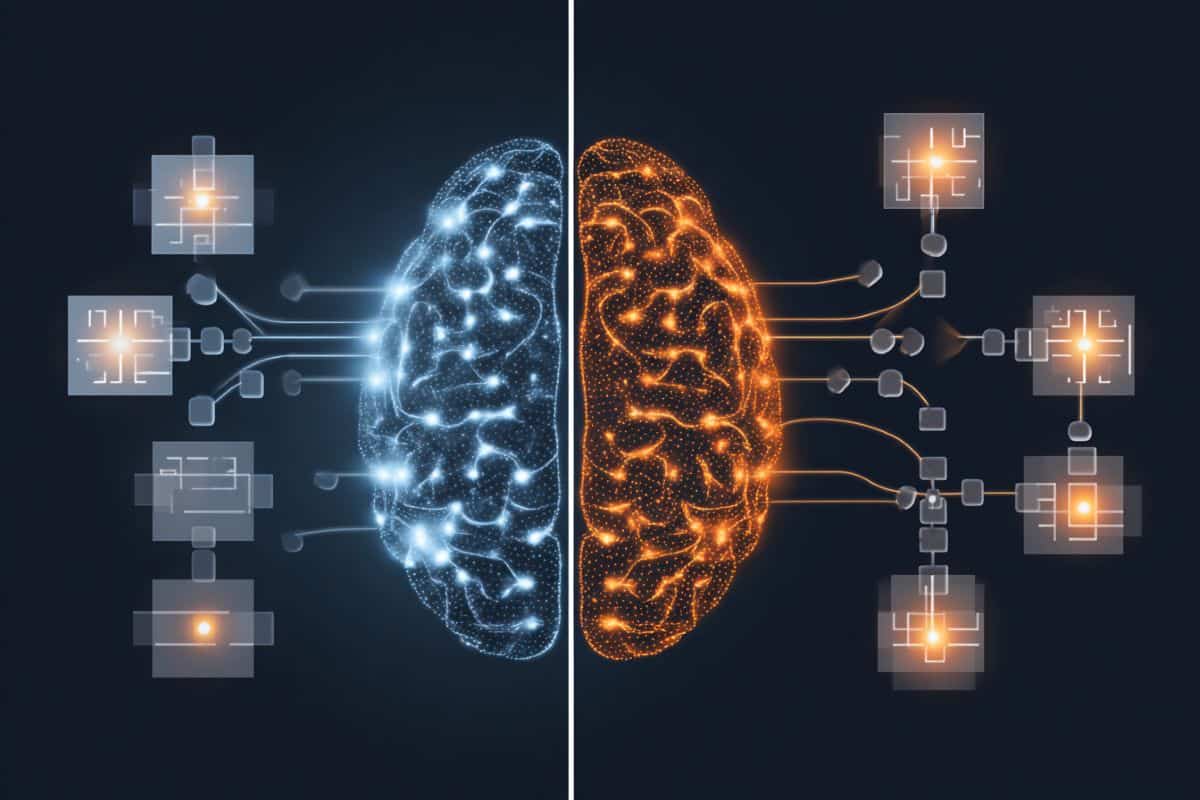Summary: Researchers discovered how the brain develops reliable visual processing once the eyes open. Early on, visual inputs and modular brain responses are mismatched, creating inconsistent patterns.
With experience, neurons align their signals to the correct modules, and interconnected modules begin working together on the same features, allowing the brain to form stable representations of the visual world. This developmental sequence shows how the brain is primed for rapid learning, offering clues to broader mechanisms of perception and learning.
Key Facts
- Early Mismatch: Before eye opening, neurons send inconsistent signals to visual modules.
- Experience Matters: After visual input, neurons and modules align, stabilizing visual responses.
- Learning Boost: Pre-wired modular activity primes the brain for rapid, efficient learning.
Source: Max Planck Institute
The brain is a highly organized structure. Like other brain regions, visual areas have structure to them, which scientists call modules This modular organization consists of patches of neurons that activate together in response to specific information.
For example, some patches of neurons activate together in response to seeing vertical stripes, while other patches activate when horizontal stripes are seen. In the mature brain, modules specialized to activate in response to a specific feature are highly interconnected with one another, allowing these modules to activate together reliably in response to that feature.

This reliability is crucial for the animal to interpret its environment and make sight-based decisions. Yet, little is known about how the structure that underlies this reliability develops.
Senior author of the study, Dr. David Fitzpatrick, describes the rationale for their work, “Our goal is to understand how the brain develops the ability to interpret visual information. Our team previously found that when the eyes first open, brain responses to the same visual scene are inconsistent.
“Different groups of neurons respond each time, which limits the brain’s ability to make sense of its surroundings. Remarkably, within a short period, these responses become highly reliable, forming consistent patterns that allow the brain to interpret the visual world and guide behavior.”
To determine how reliable modular responses in the brain emerge, scientists needed to measure both the visual information entering the modules and the modular response to that information before and after visual experience. What they found surprised them: before experience, the information didn’t match well.
For example, neurons sending information about horizontal lines were active simultaneously with modules specialized to respond to vertical instead of horizontal lines.
To better understand their data, the scientists developed a descriptive computational model based on what is known about the structure and function of brain circuits involved in vision. The model helped them understand their data and predict what factors would be most important to develop reliable brain responses from the immature responses they measured.
The model identified two major changes that should occur:
- The visual information received by the modules must increase in reliability.
- The information coming into the modules must become better aligned with the connections between those modules.
Consistent with the first factor of their model, the scientists found that before visual experience, neurons sometimes sent information to a module that represented one feature and sometimes another feature. After visual experience, the neurons consistently sent the same information to a module. But this factor alone wasn’t enough to generate reliable modular responses.
The scientists also found evidence predicted by their model that, before experience, interconnected modules receive information that represents different features, in contrast with the experienced circuit, where highly interconnected modules respond to similar features.
“What is so exciting about our findings is that they demonstrate a new strategy that allows the brain to learn better and faster. The brain has evolved so that early in development, even before the eyes open, it is wired to produce activity patterns that are organized into modules. This property primes the brain to learn efficiently once the eyes open by aligning important information from the outside world with the modular structure,” describes first author Dr. Augusto Lempel.
Moving forward, the team plans to determine the specific changes in neural connectivity that drive the developmental alignment between visual information and modular activity. The team hypothesizes that these wiring changes might be common for many perceptions beyond vision and may be a key mechanism behind the brain’s superior ability to learn.
Dr. Lempel suggests, “The more we work with artificial intelligence, the more we appreciate just how impressive the brain is in quickly learning new information without making too many assumptions. The rapid sequence of developmental changes in circuit organization we’ve uncovered is one step forward in understanding the mechanisms that support the brain’s capacity for rapid and flexible learning.”
Funding: This research was funded by the National Eye Institute, the LOEWE Focus Center for Multiscale Modelling in Life Sciences (CMMS), the International Max Planck Research School for Neural Circuits in Frankfurt and the Max Planck Society. This content is solely the authors’ responsibility and does not necessarily represent the official views of the funders.
About this visual learning research news
Author: Lesley Colgan
Source: Max Planck Institute
Contact: Lesley Colgan – Max Planck Institute
Image: The image is credited to Neuroscience News
Original Research: Open access.
“Development of coherent cortical responses reflects increased discriminability of feedforward inputs and their alignment with recurrent circuits” by David Fitzpatrick et al. Neuron
Abstract
Development of coherent cortical responses reflects increased discriminability of feedforward inputs and their alignment with recurrent circuits
Sensory cortical areas guide behavior by transforming stimulus-driven inputs into reliable activity patterns. In the visual cortex, layer 4 (L4) neurons activated by the same edge orientation provide feedforward input to layers 2/3 (L2/3) modules sharing strong recurrent connections.
This alignment facilitates selective amplification, driving a reliable, modular representation of orientation, but how it develops remains unclear. Using electrophysiology and calcium imaging, we find that in visually naive animals, L4-L2/3 coactivity lacks orientation specificity.
One contributing factor is low orientation discriminability in L4, which improves with experience.
However, computational modeling indicates that misaligned feedforward-recurrent interactions also play a critical role and predict developmental changes in tuning dynamics of sustained L2/3 responses, which we confirm with whole-cell recordings.
Altogether, our study provides evidence that enhanced discriminability of L4 feedforward inputs and their alignment with recurrent L2/3 interactions following experience contribute to the development of reliable sensory representations with laminar-temporal coherence.







